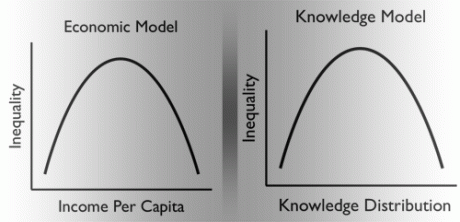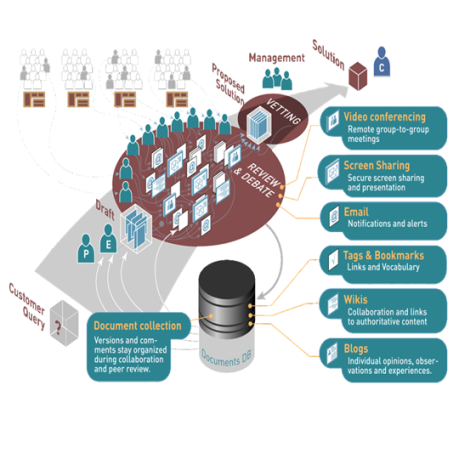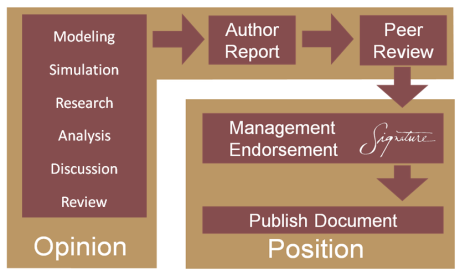Collaborative Intelligence December 4, 2008
Posted by stewsutton in Knowledge Management.Tags: collaborative intelligence
add a comment
Collaborative intelligence is a measure of the collaborative ability of a group to create, contribute to and harness the power within networks of people and relationships. Collaborative Intelligence measures the collaborative ability of a group.
In action, collaborative intelligence represented by the knowledge and problem solving capability of a group is much greater than the knowledge possessed by an individual group member. As groups work together they develop a shared memory, which is accessible through the collaborative artifacts created by the group, including meeting minutes, transcripts from threaded discussions, and drawings. The shared memory (group memory) is also accessible through the memories of group members.
What can this definition (taken from Wikipedia) lead us to conclude?
- Collaborative Intelligence (when it works) is people working together with greater collective wisdom than the summation of their individual wisdom
- Collaborative intelligence requires work (debate, review, listening, reflection, setting priority, ranking, being objective, rejecting, and promoting). These are difficult tasks that take time and energy – not easily automated by technology.
- Collaborative intelligence as an “integrator” of collective wisdom finds itself susceptible to groupthink.
Keeping an influx of new perspectives, forcing diversity in the dialog, and having a prescriptive method to drive consensus are key elements to assuring collaborative intelligence forms the basis for good results.
The current crop of web 2.0 technologies seem to be almost directed at improving collaborative intelligence. Collaborative authorship within Wikipedia is clearly working well on topics of broad interest and peer review. The blogosphere provides examples of collaborative intelligence in the post/comment cycle within topic areas less prone to flame and rage. An the tagging and bookmarking services (especially services like spock.com are integrating the diverse opinion of a group intelligence and doing so effectlively.
So collaborative intelligence is making inroads into our society and culture. Let’s hope it continues to provide benefit and value as it becomes more commonplace.
Knowledge Management Guided by Economic Valuation Models December 1, 2008
Posted by stewsutton in Knowledge Management.Tags: knowledge economics
1 comment so far
I’d like to focus on providing a measure of economic value for KM activities, and in particular the value of social software integration with KM architecture. Several years of experience in spearheading KM within a large “knowledge organization” has provided a unique perspective on attainable value. We always consider the investment needed in order to successfully establish effective KM, versus the value provided by achieving effective KM. The observation is made that despite a multitude of SSW tools and technologies, it is not always clear how the value of KM is enhanced. In order to further our understanding of KM value, I’d like to propose an analogy from capital flows to knowledge flows, and derive some observations about the quality of the knowledge, and the efficiency associated with vetting positions and efficient capital markets.
• What are some definitions that can form a basis for comparison between knowledge flow and currency flow?
• How can we judge the quality of knowledge using a historically economic frame of reference?
• Compare knowledge flow to currency flow in capital markets – are there things to be learned when we propose “knowledge = currency”?
– What are the “value metrics” that can be used to compare knowledge and currency?
– Are there valid comparisons to be made between a capital (industrial) market and a knowledge (information) market?
• Useful knowledge – term by economist Simon Kuznets [Kuznets1965]*
– From economic historian Joel Mokyr [Mokyr2001] a theory of useful knowledge*
• What – or propositional knowledge – knowledge about natural phenomena and regularities
• How – or prescriptive knowledge – techniques or tribal knowledge within the organization
• Engineering knowledge – quantitative relations between measurable properties and variables and abstract structures
• Knowledge can be in dispute and speculative, or it can be widely accepted or tight * – Tightness is a measure of consensualness of a piece of knowledge
– Knowledge Tightness – a function of the ease of verifiability – the confidence that people have in the knowledge – the willingness of people to act on that knowledge
• Confidence – the more likely people are apt to use or apply
• Consensus – the broader the agreement
• Who knows what? – What each individual knows is less important than what society as a whole knows and “can do.”
– There are very few quantum physicists, but the fruits of their knowledge are widely available to those with interest and need – just as if everyone has been taught advanced physics and quantum mechanics.
• What really counts is collective knowledge of society (and organization)
– Aggregation – how do we go from individual knowledge to collective knowledge with the greatest efficiency and lowest cost access
– Probability of Knowledge Transfer – depends on the social organization of knowledge, storage technology, and who controls access
When we compare capital markets to the marketplace for prescriptive knowledge, there is an obvious similarity:
• Capital Economics – Free movement of capital and goods with sufficient land, energy, and labor for production and delivery of products
• Knowledge Economics – Free movement of knowledge and talent with the application of prescriptive knowledge in the proper context
Equality is another topic that can be used to compare capital markets with knowledge markets. To make this comparison we must consider each market in its early stage as well as in a mature stage of operations. The specific point of comparison is rooted in the concept of economic or knowledge inequality.
FIGURE-1: Economic Inequality vs Knowledge Inequality
This point of comparison has been formulated by expanding on the work of Simon Kuznets and specifically the Kuznets curve. Kuznets curve is a representation of Simon Kuznets’s theory that economic inequality increases over time while a country is developing, then after a critical average income is attained, begins to decrease. This offers an interesting comparison with knowledge development and sharing within an organization. Consider the following aspects of knowledge management at both early stage and maturity.
Early Stage Knowledge vs Currency
Currency – During early stages of development, when investment in physical capital is the main mechanism of economic growth, inequality encourages growth by allocating resources towards those who create additional value, save, and invest the most.
Knowledge Comparison – Within an organization that is new, a large percentage of resources is directed at the formulation of differentiable prescriptive knowledge – the organizational techniques that will provide differentiable value to customers.
Consider the following techniques to combat inequality in the distribution and exchange of knowledge during early stage operations:
· Establish recording process for dissenting opinions
· Allow parallel authorship of material that has not been fully developed
· Build peer-assists, after action reviews, and just-in-time learning into the product delivery process
Mature Stage Knowledge vs Currency
Currency – In mature economies human capital accrual (an estimate of cost that has been incurred but not yet paid) replaces physical capital accrual as the main source of growth. Inequality slows growth by lowering education standards because poor people lack finance for their education in imperfect credit markets.
Knowledge Comparison – In organizations with mature prescriptive knowledge (techniques about how to apply propositional knowledge) efficiency of the workforce that has prescriptive knowledge is high, while transfer of this knowledge to those lacking is in conflict with the production efficiency of the prescriptive knowledge experts as they complete their work tasks.
The following techniques are proposed to combat inequality in the distribution and exchange of knowledge during mature stage operations:
· Enable syndication allowing mashups of established prescriptive material
· Assure that authoritative knowledge sources are well documented and available to all members of staff
· Make reciprocal mentorship between legacy staff and new hires a standard
The flow of knowledge and it processing and vetting within the enterprise facilitated by Web 2.0 social software technology is illustrated in the figure below. In this figure we notice that a select collection of technology is “wired into” the prescriptive process of collaborative forming, vetting, and delivery of knowledge.
FIGURE-2: Knowledge Forming to Solution
Note that participants in this activity conform to a very deliberate process in creating a community position for a specific topic. That process framework is shown in Figure-3.
FIGURE-3: Community Position Process
Social software can be effective in achieving both high consensus as well as tighter agreement on the knowledge. While without a prescriptive process to guide Web 2.0 technology usage, this same technology that can provide a powerful adjunct to knowledge creation can devolve into a taskmaster of endless distraction. The “distracted worker” that is a slave to email, instant messages, work status updates, and tending their “blog and wiki garden” is not the goal. Technology adaptation must follow a prescriptive process that is in tune with the organizational culture. Only then does the propositional knowledge combine with experience to create lasting value.
It is possible to further explore additional analogies between the industrial economy and the information and knowledge economies. Compare the value of infrastructure and services, as well the “soft” aspects of the human interface and the organizational behavior. Output can be collective knowledge, versus production for an economy or organization.
One can argue that efficient knowledge markets allow for effective availability of knowledge when and where it is needed. The tools that facilitate that collectively are more effective when such flows are achieved with less organizational and individual effort.


